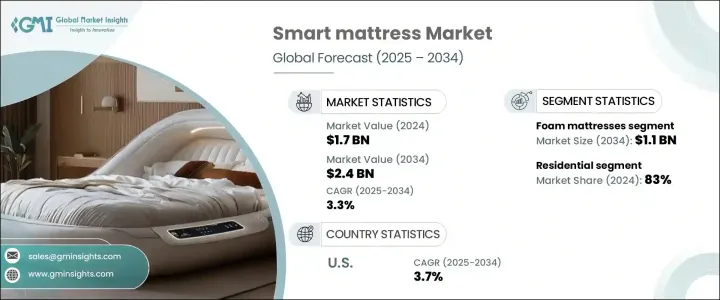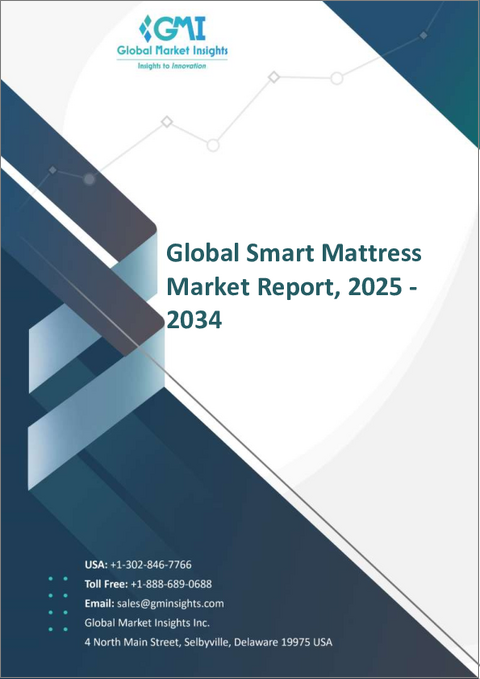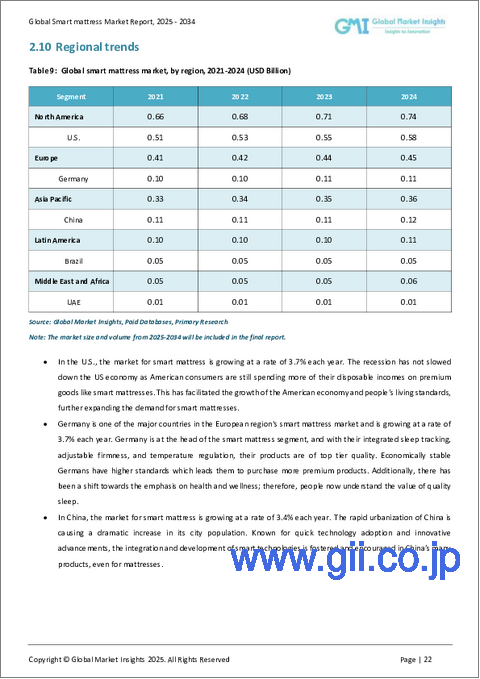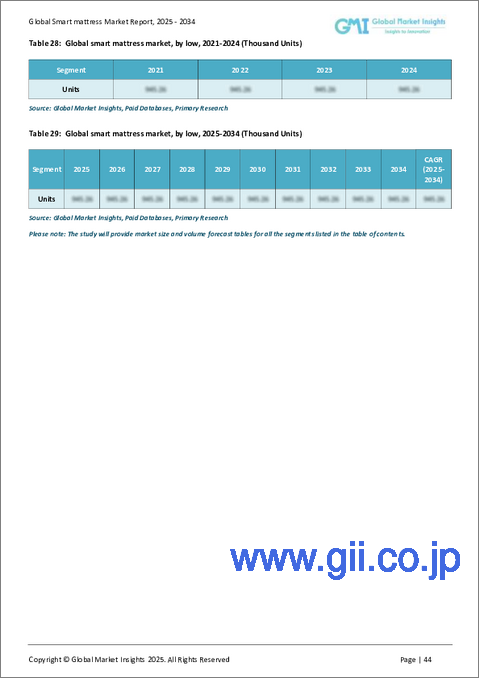|
|
市場調査レポート
商品コード
1716688
スマートマットレスの市場機会、成長促進要因、産業動向分析、2025年~2034年の予測Smart Mattress Market Opportunity, Growth Drivers, Industry Trend Analysis, and Forecast 2025 - 2034 |
||||||
カスタマイズ可能
|
|||||||
| スマートマットレスの市場機会、成長促進要因、産業動向分析、2025年~2034年の予測 |
|
出版日: 2025年03月07日
発行: Global Market Insights Inc.
ページ情報: 英文 150 Pages
納期: 2~3営業日
|
全表示
- 概要
- 目次
スマートマットレスの世界市場は2024年に17億米ドルとなり、2025年から2034年にかけてCAGR3.3%で成長すると予測されています。
同市場は、良質な睡眠が全体的な健康と幸福にとっていかに不可欠であるかについて消費者の認識が高まっていることから、勢いを増しています。個人に合わせた快適さへの注目の高まりとスマートホーム技術の急増により、スマートマットレスは、睡眠最適化のための高度なソリューションを求める消費者の間で好ましい選択肢として浮上しています。これらのマットレスは、温度調節、動作検知、睡眠サイクル分析、自動硬さ調整などの統合技術を備え、従来の寝具をはるかに上回る機能を提供するよう設計されています。

消費者は現在、ウェルネスと健康的なライフスタイルを促進する製品を優先しており、スマートマットレスはこの傾向にシームレスに適合しています。センサー技術、AIによる睡眠モニタリング、スマートホームの統合などの革新が需要をさらに促進しています。睡眠の質を向上させる方法を求める人が増える中、睡眠データの追跡・分析、サポートゾーンの調整、他のスマートデバイスとの同期が可能なマットレスの魅力は高まり続けています。さらに、素材や製造工程の進歩による価格の低下により、スマートマットレスはより手頃な価格となり、より幅広い消費者層が利用しやすくなっています。技術に精通したミレニアル世代から、より良い睡眠ソリューションを求める高齢者まで、市場の魅力は幅広い層に及んでおり、年々一貫した成長を牽引しています。
| 市場範囲 | |
|---|---|
| 開始年 | 2024年 |
| 予測年 | 2025年~2034年 |
| 開始金額 | 17億米ドル |
| 予測金額 | 24億米ドル |
| CAGR | 3.3% |
市場は、フォームマットレス、スプリングマットレス、ハイブリッドマットレス、ラテックスマットレスなど製品タイプ別に区分されます。このうち、フォームマットレスは2024年に7億9,970万米ドルの収益を上げて市場をリードし、2034年には11億米ドルに達すると予測されています。フォームマットレスは、コスト効率よく製造でき、高度な技術機能を組み込むのに適応性が高いため、ますます支持されるようになっています。内蔵センサーとスマートファブリックを備えたこれらのマットレスは、ユーザーの睡眠パターンをモニターし、睡眠の質を高めるために温度と硬さを自動的に調整します。その汎用性と手頃な価格は、1つの製品で快適性と革新性の両方を実現することを目指すメーカーにとって、最良の選択肢となっています。消費者が、より接続性が高く応答性の高い睡眠ソリューションを求める中、フォームセグメントは優位性を維持すると予想されます。
用途別に見ると、市場は住宅用と商業用に分けられ、2024年の市場シェアは住宅用が83%を占めました。スマートマットレスは、特に人々が日常生活と健康を向上させる製品に投資するにつれて、急速に現代住宅に不可欠な要素になりつつあります。照明、サーモスタット、音声アシスタントのようなスマートホームシステムと接続する機能は、パーソナライズされた睡眠環境を作りたい住宅所有者にとって特に魅力的です。ホームオートメーションの推進と、快適さに対する消費者の期待の高まりが、住宅空間におけるスマートマットレス人気の主な原動力となっています。
米国のスマートマットレス市場はCAGR3.7%で拡大しており、経済の不確実性にもかかわらず、健康に焦点を当てたプレミアム製品への投資意欲が高まっている消費者がその原動力となっています。米国の消費者は、優れた快適性と健康上のメリットを約束する、ハイテクを駆使したハイエンドの睡眠ソリューションを好む傾向が強まっています。睡眠の健康が優先されるようになり、技術革新が寝具業界の形を変え続けているため、米国のスマートマットレスの需要は引き続き堅調に推移すると予想されます。
目次
第1章 調査手法と調査範囲
第2章 エグゼクティブサマリー
第3章 業界洞察
- 業界エコシステム分析
- バリューチェーンに影響を与える要因
- 利益率分析
- ディスラプション
- 将来の展望
- メーカー
- 流通業者
- 小売業者
- 影響要因
- 成長促進要因
- 睡眠の質の重要性に対する消費者の意識の高まり
- スマートホームデバイスとIoT統合の採用拡大
- AIによる睡眠トラッキングと生体認証モニタリングの採用増加
- 業界の潜在的リスク・課題
- 高コスト
- プライバシーへの懸念
- 成長促進要因
- 消費者の購買行動分析
- 人口動態の動向
- 購買決定に影響を与える要因
- 消費者の製品採用
- 好みの流通チャネル
- 希望価格帯
- 成長可能性分析
- 規制状況
- 価格分析
- ポーター分析
- PESTEL分析
第4章 競合情勢
- イントロダクション
- 企業市場シェア分析
- 競合のポジショニングマトリックス
- 戦略展望マトリックス
第5章 市場推計・予測:製品タイプ別、2021年~2034年
- 主要動向
- フォームマットレス
- スプリングマットレス
- ハイブリッドマットレス
- ラテックスマットレス
- その他
第6章 市場推計・予測:サイズ別、2021年~2034年
- 主要動向
- 小
- 中
- 大
第7章 市場推計・予測:高さ別、2021年~2034年
- 主要動向
- 5インチ以下
- 5インチ~10インチ
- 10インチ以上
第8章 市場推計・予測:硬さレベル別、2021年~2034年
- 主要動向
- ソフト
- ミディアム
- 硬め
第9章 市場推計・予測:価格帯別、2021年~2034年
- 主要動向
- 低
- 中
- 高
第10章 市場推計・予測:用途別、2021年~2034年
- 主要動向
- 住宅用
- 商業用
第11章 市場推計・予測:流通チャネル別、2021年~2034年
- 主要動向
- オンライン
- オフライン
第12章 市場推計・予測:地域別、2021年~2034年
- 主要動向
- 北米
- 米国
- カナダ
- 欧州
- 英国
- ドイツ
- フランス
- イタリア
- スペイン
- アジア太平洋
- 中国
- 日本
- インド
- 韓国
- オーストラリア
- ラテンアメリカ
- ブラジル
- メキシコ
- 中東・アフリカ
- 南アフリカ
- サウジアラビア
- アラブ首長国連邦
第13章 企業プロファイル
- Amerisleep
- Casper Sleep Inc.
- Eight Sleep
- Hilding Anders
- iOBED
- Kingsdown, Inc.
- Leesa Sleep
- Nolah Sleep
- Purple Innovation, LLC
- ReST(Responsive Surface Technology)
- Serta Simmons Bedding, LLC
- Sleep Number Corporation
- Tempur Sealy International, Inc.
- Xiaomi
- Zeeq by REM-Fit
The Global Smart Mattress Market was valued at USD 1.7 billion in 2024 and is projected to grow at a CAGR of 3.3% between 2025 and 2034. The market is gaining momentum as consumers are becoming increasingly aware of how essential good sleep is to overall health and well-being. With a rising focus on personalized comfort and the surge in smart home technologies, smart mattresses are emerging as a preferred choice among consumers seeking advanced solutions for sleep optimization. These mattresses are designed to offer much more than traditional bedding, featuring integrated technologies such as temperature regulation, motion detection, sleep cycle analysis, and automatic firmness adjustment.

Consumers are now prioritizing products that promote wellness and healthy lifestyles, and smart mattresses fit seamlessly into this trend. Innovations in sensor technology, AI-driven sleep monitoring, and smart home integration are further fueling demand. As more people look for ways to improve their sleep quality, the appeal of mattresses that can track and analyze sleep data, adjust support zones, and sync with other smart devices continues to grow. Moreover, declining prices due to advancements in materials and manufacturing processes are making smart mattresses more affordable and accessible to a broader consumer base. From tech-savvy millennials to older adults seeking better sleep solutions, the market is attracting a wide demographic, driving consistent growth year over year.
| Market Scope | |
|---|---|
| Start Year | 2024 |
| Forecast Year | 2025-2034 |
| Start Value | $1.7 Billion |
| Forecast Value | $2.4 Billion |
| CAGR | 3.3% |
The market is segmented by product type, including foam, innerspring, hybrid, and latex mattresses. Among these, foam mattresses led the market with revenue of USD 799.7 million in 2024 and are anticipated to reach USD 1.1 billion by 2034. Foam mattresses are increasingly favored because they are cost-effective to manufacture and highly adaptable for integrating advanced technological features. Equipped with embedded sensors and smart fabrics, these mattresses monitor users' sleep patterns and automatically adjust temperature and firmness to enhance sleep quality. Their versatility and affordability make them a top choice for manufacturers aiming to deliver both comfort and innovation in one product. As consumers demand more connected and responsive sleep solutions, the foam segment is expected to maintain its dominance.
Based on application, the market is divided into residential and commercial segments, with the residential sector accounting for an 83% market share in 2024. Smart mattresses are quickly becoming an integral part of modern homes, especially as people invest in products that improve daily life and health. Their ability to connect with smart home systems like lighting, thermostats, and voice assistants makes them particularly attractive to homeowners looking to create personalized sleep environments. The push for home automation and growing consumer expectations for comfort are key drivers behind the popularity of smart mattresses in the residential space.
The U.S. Smart Mattress Market is expanding at a CAGR of 3.7%, driven by increasing consumer willingness to invest in premium, health-focused products despite economic uncertainties. American consumers are showing a growing preference for high-end, tech-enhanced sleep solutions that promise superior comfort and health benefits. As sleep health becomes a priority and innovation continues to reshape the bedding industry, demand for smart mattresses in the U.S. is expected to remain strong.
Table of Contents
Chapter 1 Methodology & Scope
- 1.1 Market scope & definition
- 1.2 Base estimates & calculations
- 1.3 Forecast parameters
- 1.4 Data sources
- 1.4.1 Primary
- 1.5 Secondary
- 1.5.1.1 Paid sources
- 1.5.1.2 Public sources
Chapter 2 Executive Summary
- 2.1 Industry synopsis, 2021 - 2034
Chapter 3 Industry Insights
- 3.1 Industry ecosystem analysis
- 3.1.1 Factor affecting the value chain
- 3.1.2 Profit margin analysis
- 3.1.3 Disruptions
- 3.1.4 Future outlook
- 3.1.5 Manufacturers
- 3.1.6 Distributors
- 3.1.7 Retailers
- 3.2 Impact forces
- 3.2.1 Growth drivers
- 3.2.1.1 Increasing consumer awareness about the importance of sleep quality
- 3.2.1.2 The growing adoption of smart home devices and IoT integration
- 3.2.1.3 Rising adoption of AI-driven sleep tracking and biometric monitoring
- 3.2.2 Industry pitfalls & challenges
- 3.2.2.1 High cost
- 3.2.2.2 Privacy concern
- 3.2.1 Growth drivers
- 3.3 Consumer buying behavior analysis
- 3.3.1 Demographic trends
- 3.3.2 Factors affecting buying decision
- 3.3.3 Consumer product adoption
- 3.3.4 Preferred distribution channel
- 3.3.5 Preferred price range
- 3.4 Growth potential analysis
- 3.5 Regulatory landscape
- 3.6 Pricing analysis
- 3.7 Porter's analysis
- 3.8 PESTEL analysis
Chapter 4 Competitive Landscape, 2024
- 4.1 Introduction
- 4.2 Company market share analysis
- 4.3 Competitive positioning matrix
- 4.4 Strategic outlook matrix
Chapter 5 Market Estimates and Forecast, By Product Type, 2021 - 2034 (USD Billion) (Million Units)
- 5.1 Key trends
- 5.2 Foam mattresses
- 5.3 Innerspring mattresses
- 5.4 Hybrid mattresses
- 5.5 Latex mattresses
- 5.6 Others
Chapter 6 Market Estimates & Forecast, By Size, 2021 - 2034 (USD Billion) (Million Units)
- 6.1 Key trends
- 6.2 Small
- 6.3 Medium
- 6.4 Large
Chapter 7 Market Estimates & Forecast, By Height, 2021 - 2034 (USD Billion) (Million Units)
- 7.1 Key trends
- 7.2 Below 5 inch
- 7.3 5 inch - 10 inch
- 7.4 Above 10 inch
Chapter 8 Market Estimates & Forecast, By Firmness Level, 2021 - 2034 (USD Billion) (Million Units)
- 8.1 Key trends
- 8.2 Soft
- 8.3 Medium
- 8.4 Firm
Chapter 9 Market Estimates & Forecast, By Price Range, 2021 - 2034 (USD Billion) (Million Units)
- 9.1 Key trends
- 9.2 Low
- 9.3 Medium
- 9.4 High
Chapter 10 Market Estimates & Forecast, By Application, 2021 - 2034 (USD Billion) (Million Units)
- 10.1 Key trends
- 10.2 Residential
- 10.3 Commercial
Chapter 11 Market Estimates & Forecast, By Distribution Channel, 2021 - 2034 (USD Billion) (Million Units)
- 11.1 Key trends
- 11.2 Online
- 11.3 Offline
Chapter 12 Market Estimates & Forecast, By Region, 2021 - 2034, (USD Billion) (Million Units)
- 12.1 Key trends
- 12.2 North America
- 12.2.1 U.S.
- 12.2.2 Canada
- 12.3 Europe
- 12.3.1 UK
- 12.3.2 Germany
- 12.3.3 France
- 12.3.4 Italy
- 12.3.5 Spain
- 12.4 Asia Pacific
- 12.4.1 China
- 12.4.2 Japan
- 12.4.3 India
- 12.4.4 South Korea
- 12.4.5 Australia
- 12.5 Latin America
- 12.5.1 Brazil
- 12.5.2 Mexico
- 12.6 MEA
- 12.6.1 South Africa
- 12.6.2 Saudi Arabia
- 12.6.3 UAE
Chapter 13 Company Profiles (Business Overview, Financial Data, Product Landscape, Strategic Outlook, SWOT Analysis)
- 13.1 Amerisleep
- 13.2 Casper Sleep Inc.
- 13.3 Eight Sleep
- 13.4 Hilding Anders
- 13.5 iOBED
- 13.6 Kingsdown, Inc.
- 13.7 Leesa Sleep
- 13.8 Nolah Sleep
- 13.9 Purple Innovation, LLC
- 13.10 ReST (Responsive Surface Technology)
- 13.11 Serta Simmons Bedding, LLC
- 13.12 Sleep Number Corporation
- 13.13 Tempur Sealy International, Inc.
- 13.14 Xiaomi
- 13.15 Zeeq by REM-Fit






